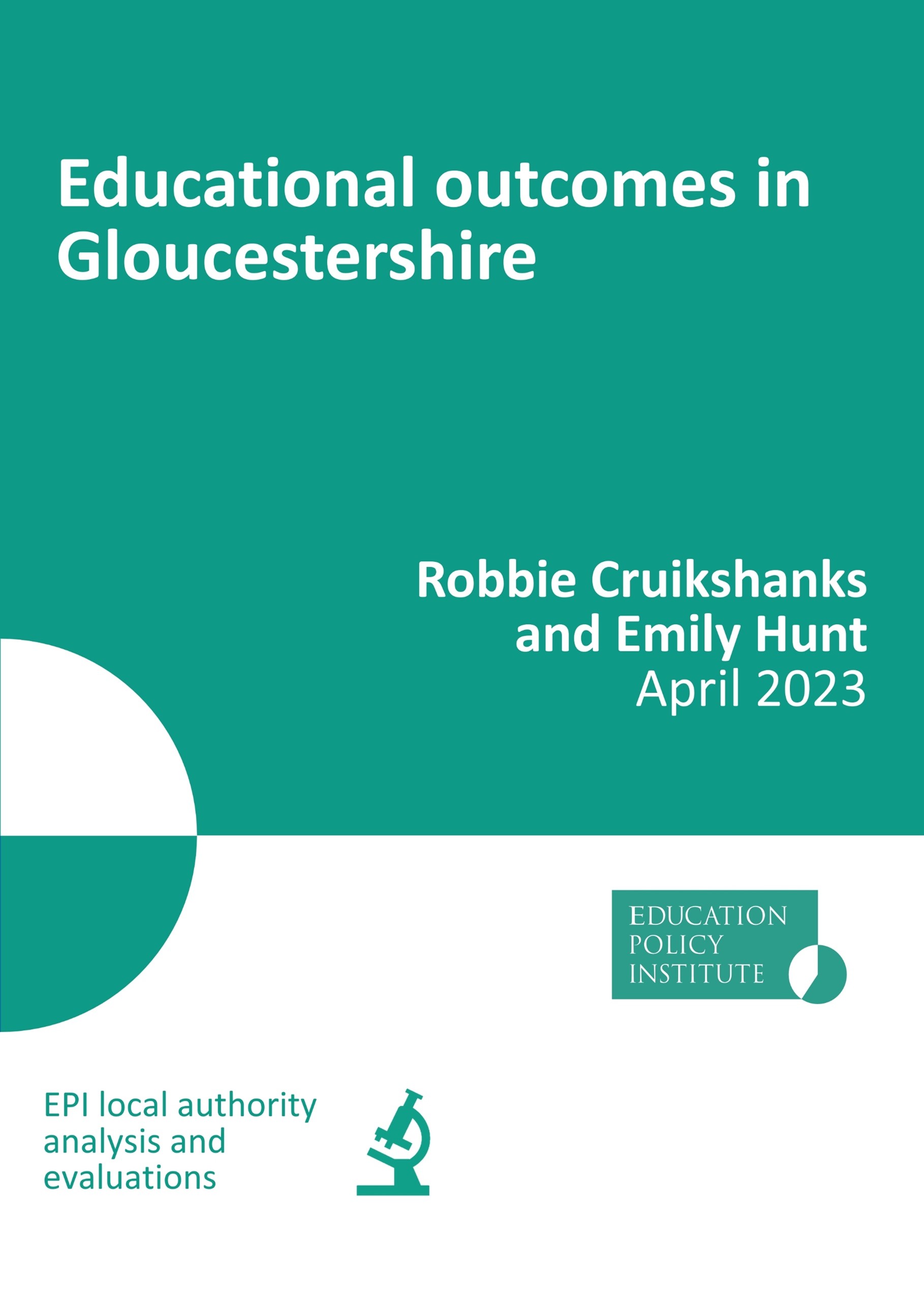In a new report, the Education Policy Institute (EPI), commissioned by the Gloucestershire Education Forum, reports on the state of educational inequalities across multiple phases of education in Gloucestershire and how this has changed over the past decade.
The report sets out the current position of the disadvantage gap across multiple phases of education in Gloucestershire, and how this has changed over the past decade to 2021. The report positions Gloucestershire’s disadvantage gap alongside the national average for England, as well as the wider South West to provide more context on how well Gloucestershire enables disadvantaged children to achieve.
Through our analysis of the characteristics, attainment and disadvantage gaps of learners in Gloucestershire, and a range of similar local authorities, we show that while disadvantaged pupils in Gloucestershire tend to be further behind than their national counterparts, the local authority generally performs favourably when compared to similar local authorities.
Read the report in full here:
Key findings:
Early years
- Reception pupils in Gloucestershire are less likely to be disadvantaged than across England as a whole. The share of pupils aged 5 (in Reception year) in Gloucestershire who were eligible for free school meals was 9.7 per cent in 2019, compared with 14.3 per cent nationally. Since the start of our series in 2013, there has been a trend of falling levels of disadvantage in Gloucestershire and nationally prior to the pandemic, though data from the DfE shows this proportion increased in 2022 to 11.2 per cent compared with the national average of 18.8 per cent.
- Overall attainment at age 5 is higher in Gloucestershire than the national average. In 2019, Reception pupils in Gloucestershire had an average total point score on the early years foundation stage profile of 35.5 points, compared with 34.6 points nationally (on a scale from 17 to 51). The highest scoring local authority was Richmond-upon-Thames (39.3) and the lowest was Middlesborough (32.3), with Gloucestershire in the top quartile of all local authorities.
- The early years disadvantage gap in Gloucestershire has fluctuated above and below the national average in recent years but was slightly below the national average in 2019. The average gap in attainment between disadvantaged pupils and their non-disadvantaged peers fell to 4.2 months in Gloucestershire in 2019 – its lowest level since 2013 and just below the national gap of 4.6 months. Gloucestershire has a larger early years disadvantage gap than 37 per cent of local authorities in England.
Key stage 2
- Gloucestershire’s primary school pupils are also less likely to be disadvantaged than the national average. In 2019, 23.1 per cent of pupils finishing key stage 2 (KS2) in Gloucestershire were eligible for free school meals at any point in the previous six years, compared with 29.3 per cent nationally. Whilst the national share of disadvantaged pupils has gradually been falling in recent years, in Gloucestershire it has remained largely static since 2015. DfE data from 2022 shows that Gloucestershire continues to have a lower proportion of FSM-eligible pupils at the end of primary school than the national average.
- At KS2 and KS4 we also consider pupils who are persistently disadvantaged based on being eligible for free school meals for at least 80 per cent of their time in school. In Gloucestershire, 7.8 per cent of pupils are persistently disadvantaged by the time they finish primary school, compared with 10.9 per cent nationally.
- Gloucestershire has similar average KS2 attainment to the national average, although four of its six parliamentary constituencies have below-average attainment, with the Gloucestershire-wide average being brought up by Stroud and The Cotswolds. The average scaled score in reading and maths in Gloucestershire in 2019 was 103.5 points, compared to the national average of 103.2. To put these figures in context, the highest scoring local authority was Richmond-upon-Thames with an average score of 107.9 and the lowest was Hackney with an average score of 100.8.
- The disadvantage gap at the end of primary school in Gloucestershire has been slightly wider than in England in recent years, having previously been close to the national average up to 2014. Disadvantaged pupils were 10.9 months behind at the end of KS2 in 2019, compared with 9.3 months nationally. Gloucestershire has a larger disadvantage gap at KS2 than 72 per cent of local authorities in England. Without attainment data in 2020 and 2021, it is difficult to draw conclusions on the trends in the disadvantage gap since the onset of the pandemic, though initial signs are that the gap in Gloucestershire has remained static between 2019 and 2022, while the national disadvantage gap has increased by 0.5 points.
- As with the headline KS2 disadvantage gap, the persistent disadvantage gap at the end of primary school is also larger in Gloucestershire than the national average. In 2014, the gap in Gloucestershire was close to the national average but between 2014 and 2018 the Gloucestershire gap started to pull away, reaching its peak in 2018 at 15.3 months. In 2019, the Gloucestershire gap narrowed (to 14.6 months) but remained above the national average (of 12.1 months).
Key stage 4
- As at early years and key stage 2, a smaller proportion of pupils are disadvantaged at the end of secondary school in Gloucestershire than in England (16.5 per cent in 2021, compared with 24.5 per cent nationally). Trends over time in Gloucestershire have closely matched the national picture, albeit at much lower levels of disadvantage. DfE data from 2022 shows that Gloucestershire continues to have a lower proportion of FSM-eligible pupils finishing secondary school than the national average.
- KS4 pupils in Gloucestershire are also much less likely to be growing up in long-term poverty than the national average. In Gloucestershire, 6.2 per cent of pupils finishing their GCSEs in 2021 had been eligible for free school meals for at least 80 per cent of their school life, the highest proportion in the last decade, though still well below the national figure of 10.2 per cent.
- Overall GCSE attainment is higher in Gloucestershire than in England. In 2021 the average GCSE grade in English and maths in Gloucestershire was 5.20 compared to 4.95 nationally, putting Gloucestershire in the top quartile of all local authorities. The best performance in 2021 for any local authority was Richmond-upon-Thames (with an average grade of 5.96), and the lowest was Blackpool (4.30).
- The GCSE disadvantage gap in Gloucestershire has been consistently higher than the national average over the last decade. Although disadvantaged pupils’ grades in Gloucestershire initially made up some ground during the pandemic (with the measured gap falling in 2020 and 2021 towards the national gap), the Gloucestershire gap then widened again in 2022 and reversed most of the apparent progress that disadvantaged pupils had made during the two previous years. Gloucestershire has a larger disadvantage gap at KS4 than 42 per cent of local authorities in England.
16-19 education
- Despite having higher-than-average GCSE attainment, Gloucestershire pupils are less likely to participate in education and training at ages 16 and 17 than nationally (85 per cent compared to 87 per cent). And whilst this share has been rising in Gloucestershire between 2020 and 2022 – mirroring the national picture – there has also been a small but steady increase in the proportion not in Education, Employment, or Training (NEET) in Gloucestershire, in contrast to England where this proportion has fallen slightly.
- After completing 16-to-18 study, a similar proportion of Gloucestershire students go onto higher education as nationally (37 per cent compared to 36 per cent), fewer progress to further education (8 per cent compared to 13 per cent) and a higher share are in employment (28 per cent compared to 21 per cent). Overall, a lower share are in an unsustained destination after leaving 16 to 18 study, though this proportion has been rising in recent years in Gloucestershire.
- There is little difference in the rates of progression to higher education among non-disadvantaged young people in Gloucestershire compared with non-disadvantaged young people nationally. However, disadvantaged young people in Gloucestershire are notably less likely to progress to higher education (or further education) than disadvantaged young people nationally, and are instead much more likely to enter employment immediately after 16 to 18 study.
- A slightly higher proportion of 19-year-olds in Gloucestershire achieve Level 2 and Level 3 qualifications than in England nationally. Focusing specifically on Level 3 qualifications, young people in Gloucestershire taking A levels typically achieve similar grades to their national counterparts, whilst those taking applied general qualifications and notably tech levels have begun to outperform the national average since 2020.
- Gloucestershire has a larger 16-19 disadvantage gap than the national average across students’ best three qualifications, reaching its highest level in 2021 at 4.5 grades compared to the national average of 3.1.
The Gloucestershire Education Forum was established in April 2022 to build a positive and productive partnership between all stakeholders in the county’s education system.
The Forum serves as an impartial ambassador for every child – circa 7,000 per age cohort – educated in Gloucestershire, rooted in shared values and ambitions.
The Forum’s key aims are to:
- Improve well–being and academic outcomes for all children and young people;
- Co–design a partnership–led system;
- Promote system generosity;
- Provide opportunities for professional development.


